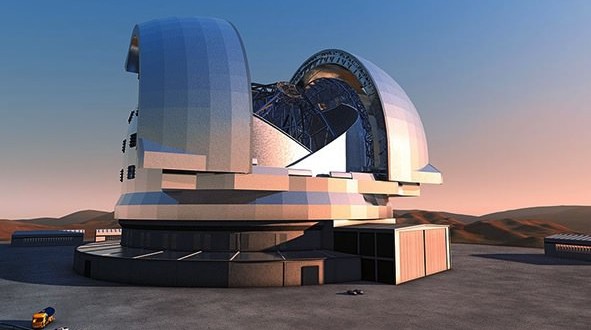The European Southern Observatory has blasted off the top of 3,000 meter high Cerro Armazones mountain in Chile to set up the European Extremely Large Telescope – “the world’s biggest eye on the sky”, according to astronomers.
The blast took place at around 17:30 GMT in the Chilean Andes at the top of the Cerro Armazones mountain. As a result the mountain top was reduced by 40 meters to provide a plateau on which the ESO will build the revolutionary new ground-based telescope.
Talking to the BBC, Dr Aprajita Verma, deputy project scientist for the E-ELT’s UK team at the University of Oxford, said “The telescope is a really huge step in terms of its scale – it’s so much bigger than anything else.
“It will give us a deeper and finer view of the universe.”
The location for the telescope – in the middle of the Atacama Desert – was chosen for its almost perfect observatory conditions, with cloudless skies nearly all year round.
The project is expected to take around 10 years, and will allow astronomers to see the birth and forming of new galaxies in incredible detail.
The possibility of being able to see life on other planets is also of key interest.
A challenging aspect for the build is the construction of the telescopes 39 metre-wide (130ft) primary mirror – which will be made of 798 smaller hexagonal mirrors, each 1.4 metres (4.6ft) in size.
The technology will allow the telescope to capture 15 times more light than any other ground based telescope and will create images that are 16 times sharper than the Hubbell telescope – which orbits high above the Earth.
The E-ELT will lead new firsts in science, like the tracking down of Earth-like planets around other stars in the ‘habitable zones’ – where life could exist. It will also perform ‘stellar archaeology’ in nearby galaxies, as well as make fundamental contributions to cosmology by probing the nature of dark matter and dark energy.
“This telescope will be so powerful that it will collect enough light to look to the observable limit of the universe – soon after the Big Bang when the first stars and galaxies formed”, said Verma.
She added, “We’ll be able to see when the universe switched on. We’ll be able to look at the planets directly, look at their atmosphere and potentially look for signs of life.”
Agencies/Canadajournal
 Canada Journal – News of the World Articles and videos to bring you the biggest Canadian news stories from across the country every day
Canada Journal – News of the World Articles and videos to bring you the biggest Canadian news stories from across the country every day



